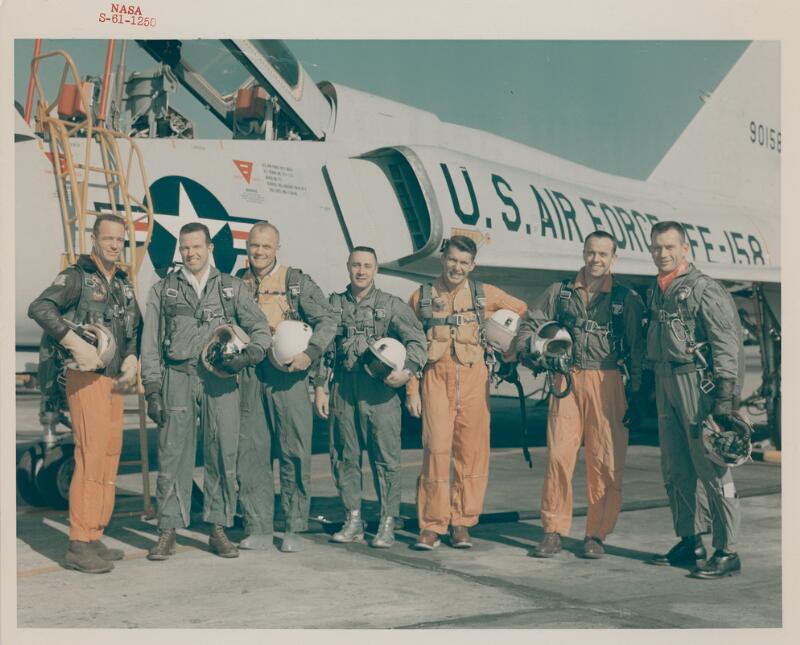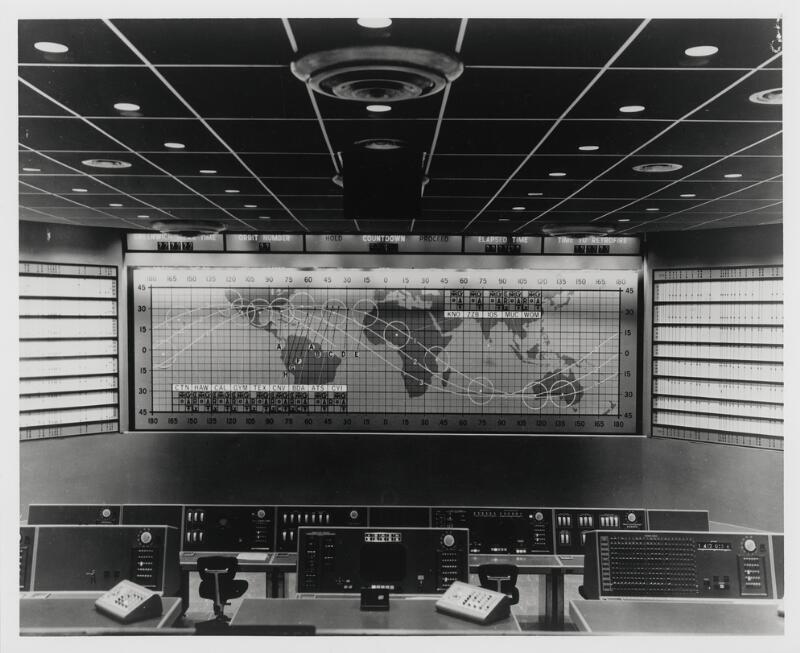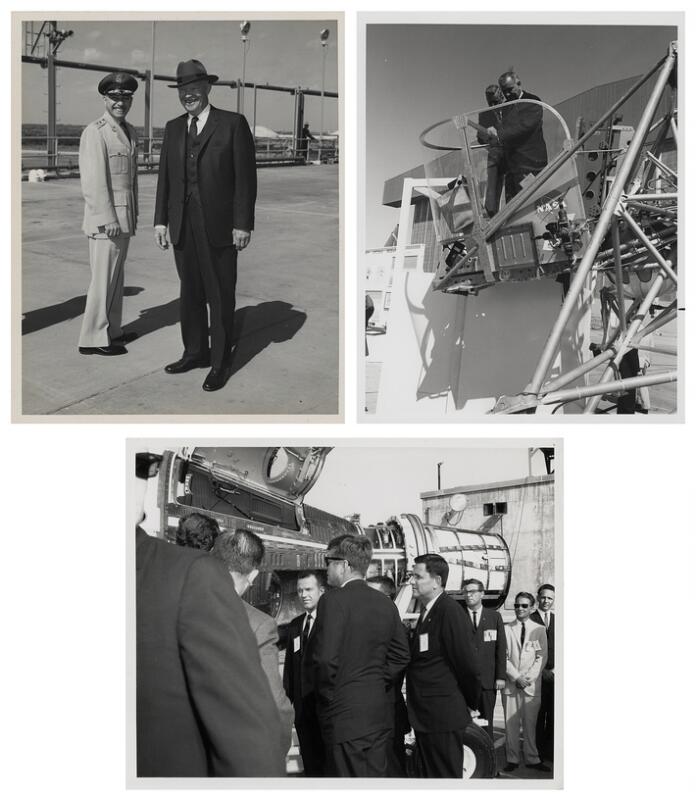[Project Mercury] The Mercury Seven, NASA’s first astronauts, presented to the world. NASA, 30 April 1959. Printed 1959. Vintage gelatin silver print on fiber-based paper [NASA image B-59–41]. 20.3×25.4 cm (8×10 in), with NASA caption on the verso, numbered “NASA B-59–41” in black in bottom margin (NASA HeadQuarters, Washington, D.C.). Literature: Apollo Expeditions to the Moon (NASA SP-350), Cortright, ed., p. 26. One of NASA’s earliest images, this iconic portrait was shot by Bill Taub, NASA’s first senior photographer. Taub photographed every mission from Mercury to Apollo and was often one of the last people to see the astronauts before liftoff, earning the nickname “Two More Taub” for his insistence on snapping just a couple more shots. The Mercury Seven were first announced to the world on April 9, 1959, and were then expected to report to the Langley Space Task Group to begin their training program only a few short weeks later, on April 27. All seven were military test pilots, a requirement specified by President Eisenhower to simplify the selection process. Taub took the photograph on April 30, 1959 during the first training period of the Mercury Seven at the Langley Research Center, Hampton, Virginia. The Mercury astronauts (from left front row Virgil “Gus” Grissom, Scott Carpenter, Donald “Deke” Slayton, Gordon Cooper, (back row) Alan Shepard, Walter Schirra and John Glenn show configuration of Atlas booster and Mercury capsule. As project Mercury began in the late 1950s, NASA’s Langley Research Center was thrust full force into the national spotlight with the arrival in Hampton of the original seven astronauts. Under the tutelage of the Space Task Group, the Seven were trained at Langley to operate the space machines that would thrust them beyond the protective environment of Earth’s atmosphere. (https://www.nasa.gov/centers/langley/home/Road2Apollo-04.html) Although the agency viewed Project Mercury’s purpose as an experiment to determine whether humans could survive space travel, the Original Seven astronauts immediately became national heroes and were compared by TIME magazine to “Columbus, Magellan, Daniel Boone and the Wright brothers”. Condition Three small binder indentations in top margin, otherwise glossy print in excellent condition. Preview In Lyngby Auction Space, 15 November 2023 Category Photos ▸ Vintage photographs Selling 15 November at 6:00 pm Estimate 5,000–7,000 DKK
Condition
[Project Mercury] The Mercury Seven, NASA’s first astronauts, presented to the world. NASA, 30 April 1959. Printed 1959. Vintage gelatin silver print on fiber-based paper [NASA image B-59–41]. 20.3×25.4 cm (8×10 in), with NASA caption on the verso, numbered “NASA B-59–41” in black in bottom margin (NASA HeadQuarters, Washington, D.C.). Literature: Apollo Expeditions to the Moon (NASA SP-350), Cortright, ed., p. 26. One of NASA’s earliest images, this iconic portrait was shot by Bill Taub, NASA’s first senior photographer. Taub photographed every mission from Mercury to Apollo and was often one of the last people to see the astronauts before liftoff, earning the nickname “Two More Taub” for his insistence on snapping just a couple more shots. The Mercury Seven were first announced to the world on April 9, 1959, and were then expected to report to the Langley Space Task Group to begin their training program only a few short weeks later, on April 27. All seven were military test pilots, a requirement specified by President Eisenhower to simplify the selection process. Taub took the photograph on April 30, 1959 during the first training period of the Mercury Seven at the Langley Research Center, Hampton, Virginia. The Mercury astronauts (from left front row Virgil “Gus” Grissom, Scott Carpenter, Donald “Deke” Slayton, Gordon Cooper, (back row) Alan Shepard, Walter Schirra and John Glenn show configuration of Atlas booster and Mercury capsule. As project Mercury began in the late 1950s, NASA’s Langley Research Center was thrust full force into the national spotlight with the arrival in Hampton of the original seven astronauts. Under the tutelage of the Space Task Group, the Seven were trained at Langley to operate the space machines that would thrust them beyond the protective environment of Earth’s atmosphere. (https://www.nasa.gov/centers/langley/home/Road2Apollo-04.html) Although the agency viewed Project Mercury’s purpose as an experiment to determine whether humans could survive space travel, the Original Seven astronauts immediately became national heroes and were compared by TIME magazine to “Columbus, Magellan, Daniel Boone and the Wright brothers”. Condition Three small binder indentations in top margin, otherwise glossy print in excellent condition. Preview In Lyngby Auction Space, 15 November 2023 Category Photos ▸ Vintage photographs Selling 15 November at 6:00 pm Estimate 5,000–7,000 DKK
Condition
.jpg)







.jpg?w=400?width=1600&quality=70)

/226/1197226.jpg)

.jpg)

Testen Sie LotSearch und seine Premium-Features 7 Tage - ohne Kosten!
Lassen Sie sich automatisch über neue Objekte in kommenden Auktionen benachrichtigen.
Suchauftrag anlegen